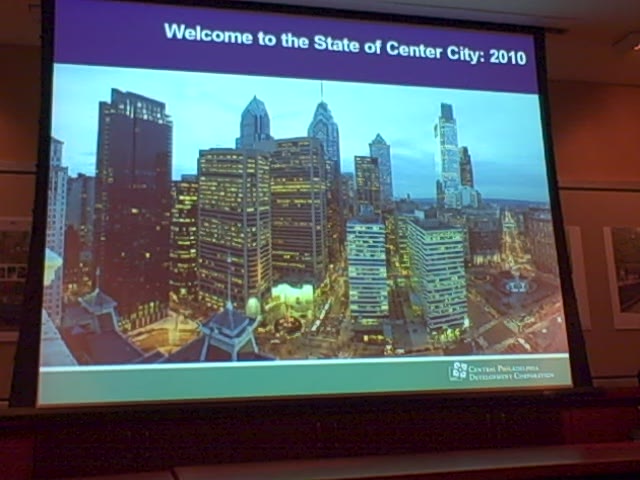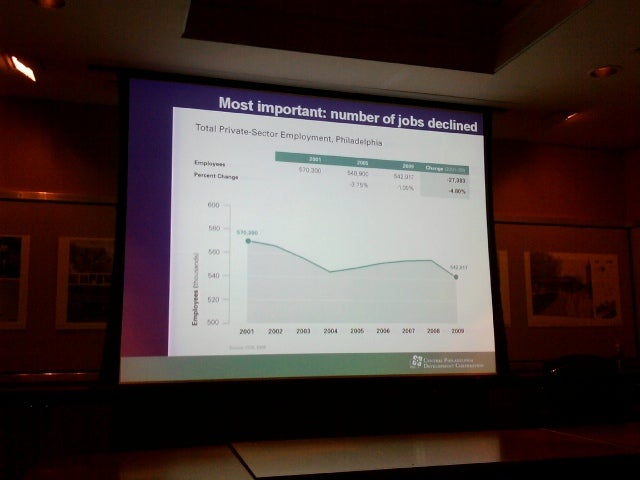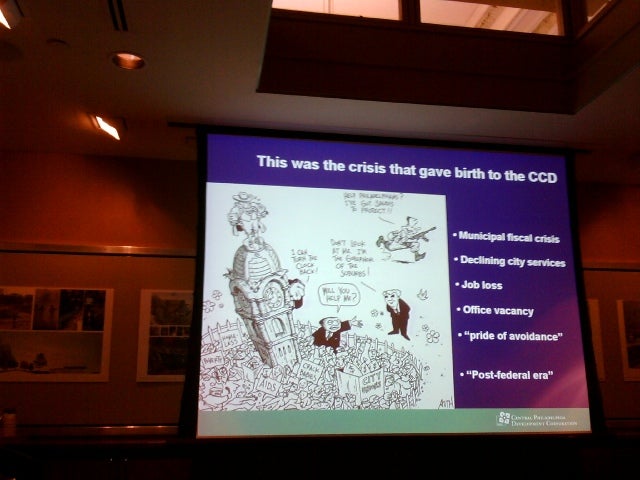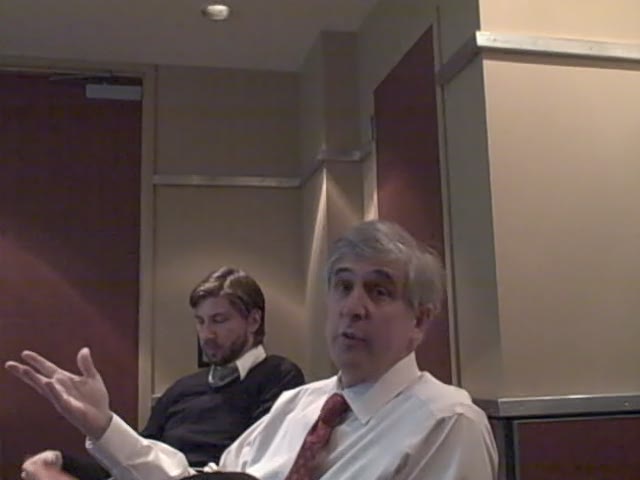We weather recession better than most, but recovery is slow
April 15, 2010
By Kellie Patrick Gates
For PlanPhilly
The last recession had less impact on Philadelphia than it did on the surrounding suburbs or on most major American cities, said Center City District President Paul Levy.
That’s never happened before, he said in a preview session on his organization’s annual State of Center City report, which is being released at an event this morning, and that’s great news. The city had fewer jobs at the end of 2009 than it did before the recession hit, Levy said. But we were protected from worse losses by our powerhouse employers. “Despite the recession, we had more jobs in education and health care in 2009 than we did in 2007,” Levy said.
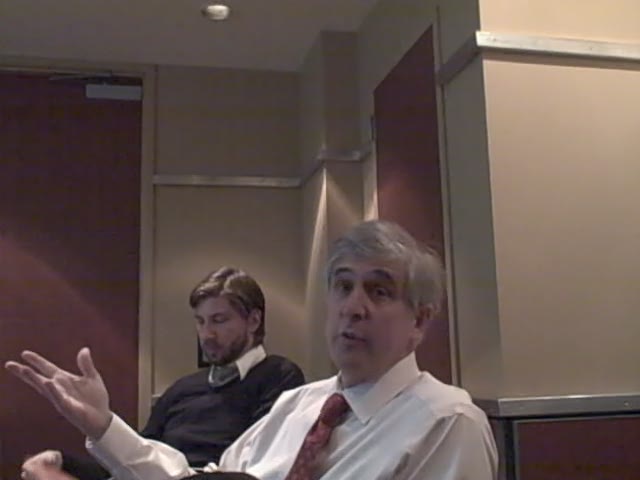
Levy talks about the report.
But now that the recovery has started, Levy fears the same old pattern is setting in again: Philadelphia is slightly behind the suburbs and the national average in job recovery. Look at the city employment trend over time, he said, and it’s clear that Philadelphia never quite regains all the jobs it loses whenever there’s a downturn.
The recovery is so new that the numbers could still turn around, Levy said – Philly just might recover apace with everyone else for a change. The city could help itself toward a much brighter outcome, he said, by capitalizing on things that are already going right, committing to resuming wage tax cuts as soon as the current economic crisis ends, and making the most of the urban-friendly administration in Washington.
https://www.youtube.com/watch?v=_vnYf9t5PPY
Levy sat on Mayor Michael Nutter’s tax advisory board, and the board’s recommendations to resume the suspended schedule of wage tax cuts are included in the CCD’s annual report. Levy said that the classic example of how the city’s tax structure impedes business development in Philadelphia still straddles City Line Avenue, the boundary between the city and Montgomery County. Both sides of the street have access to the same labor pool, the same public transportation, the same infrastructure, he said. But there is 200,000 square feet of office space on the city side, versus 2.6 million on the Bala Cynwyd side.
Levy’s talks with business leaders have shown him that many would like to be in Center City for the public transportation hubs and cultural and other amenitites the city offers its employees. “But it’s less expensive to be out in the suburbs,” he said. And these days, especially, everyone is focused on the bottom line.
Narrowing the tax gap wouldn’t be as tough as it once was, Levy said. The wage tax is now 3.9 percent for workers who live in the city, and 3.4 percent for those who live elsewhere. In recent years, most suburban municipalities have added wage taxes of at least 1 percent, Levy said. Getting the city’s rate to 3 percent would make a huge difference.
He was also quick to add that no one expects the city to cut the wage tax during a fiscal crisis. Just a verbal committment to resume cuts in coming years, maybe 2012, would go a long way, he said, because businesses think of costs over their 10-to-15 year leases.
https://www.youtube.com/watch?v=DAtO_rmVSEk
Strategic investment in transportation infrastructure is key, Levy said. The Obama administration wants to build high-speed rail capacity in the North East Corridor, and that would be a huge benefit, he said. But so would using local, state and/or federal transportation dollars to better connect areas where jobs and research are concentrated – University City and Center City.
The opportunities for cities offered by the Obama administration is the topic of the 8:30 a.m. event at the Union League where State of Center City 2010 will be formally released. Syndicated columnist Neal Peirce will discuss the implications of the Obama strategies for metro regions, and Levy will outline the findings of the report.
Among the findings:
– Center City’s year-end commercial occupancy rate, 89 percent, was the highest in the region and better than every East Coast city but Washington, D.C.
– Housing values are 7 percent below their 2006 peak, a change much less than in most other major cities.
– More than 180 new retail establishments opened last year.
– Center City ranks third nationally in the number of non-profit arts and cultural institutions per 100,000 downtown residents, behind Washington, D.C. and Manhattan. Of those cultural institutions, the most visited is the Independence Visitor Center, with 2.7 million visitors last year. The Liberty Bell had 2.3 million. The Philadelphia Zoo came in third, followed by the Constitution Center.
https://www.youtube.com/watch?v=cRQRBs6Khq0
Levy really enjoys taking a longer view of the city’s progress. “Since we’re coming up on our 20th anniversary,” he said of the Center City District, “We thought we’d look back at the last recession, in 1990 and 1991.”
Up come slides of graffiti and trashy streets.
Back then, Philadelphia had a “9-to-5” downtown, he said. There was a phenomenon he calls “pride of avoidance” where suburbanites would brag about how long it had been since they had set foot in the city.
Philadelphia had a slogan: Philadelphia’s not as bad as Philadelphians say it is. “That was the best we could do,” he said. “We were not just economically depressed, wew were physically depressed.”
Between 1994 and 2009, there was a 41.3 percent drop in major crimes in Center City and a 75.2 percent drop in thefts from cars, Levy said. People are safer than they were, and they feel safer, he said, although the recent flash mob phenomenon is “not helping.”
Credit for what Center City has going for it now goes back a long, long time.
The street grid designed by William Penn made the city seem old-fashioned and obsolete in the post-World War II era, he said. “Now, suddenly, it’s been re-infused with value.” Those walkable streets are an asset when the focus is on sustainability and rising fossil fuel costs, he said. A particularly green statistic: Center City ranks tops in the nation in the percentage of residents who walk to work, at 59 percent.
To watch more of the video presentation and a question and answer session, click here, here and here.
Contact the reporter at kelliespatrick@gmail.com.
WHYY is your source for fact-based, in-depth journalism and information. As a nonprofit organization, we rely on financial support from readers like you. Please give today.



